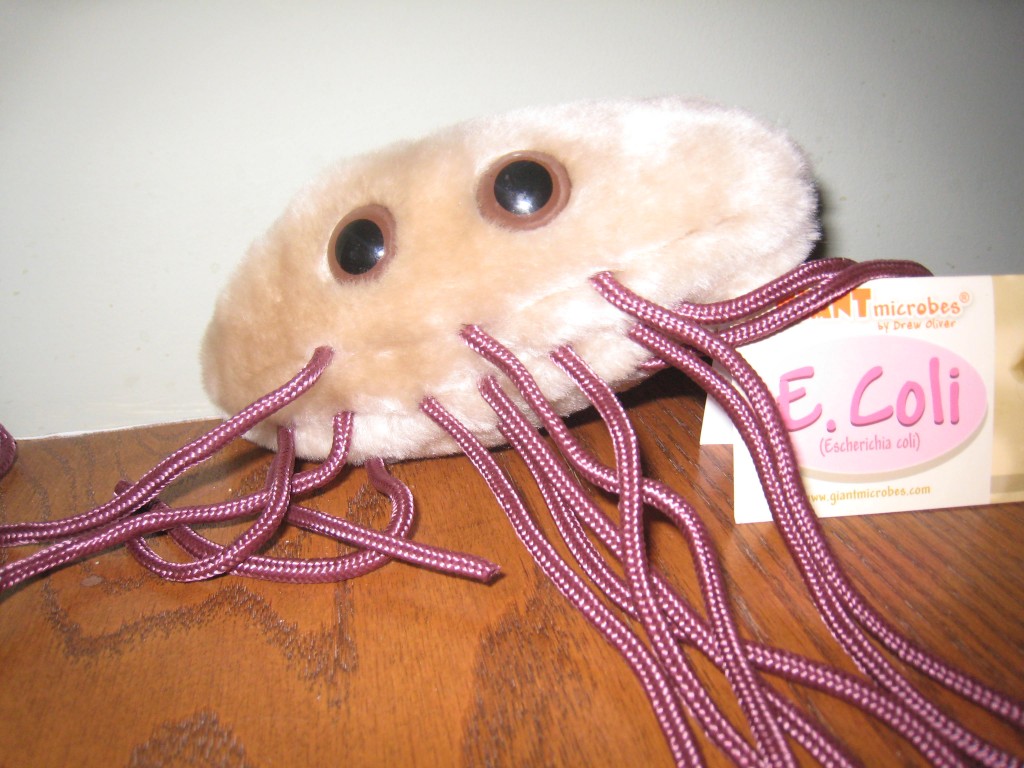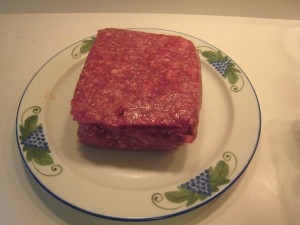Tag: E. coli’
Do E.coli have eyes?
- by KitchenPantryScientist
Last night, one of my nursing students brought this cute little E.coli bacteria in to be our microbiology class mascot.
Bacteria are classified, or grouped, by shape, and this little guy is rod-shaped just like all of his close relatives. E.coli are called gram-negative bacteria because their cell walls are put together with special building blocks that can’t be stained with certain dyes they use to tell bacteria apart from one another.
See the little ropes coming out of our mascot’s body? Some E.coli have whip-like filaments called flagella protruding from their body that can help them move around, making them “motile.”
Many E.coli are normal occupants in animal and human intestines and don’t make people sick, but there are some strains of E.coli that can make people very sick. E.coli 0157:H7 is probably the most famous of these and can be contracted from eating undercooked hamburger that has been contaminated with the bacteria.
And no, bacteria don’t have eyes. But they sure look cute on our mascot.
Raw Milk isn’t Worth the Risk
- by KitchenPantryScientist
In today’s paper, I was disgusted to read that two school-age children, a toddler and a 70-year old man were victims of an E.coli outbreak this week caused by raw milk from a Minnesota dairy. The toddler is currently hospitalized with a serious condition related to the infection (hemolytic uremic syndrome) which can cause kidney failure and death. These are unnecessary illnesses and people are putting themselves and their children at risk by drinking raw milk.
Pasteurization is the process of heating up food to kill any bacteria it might contain. Louis Pasteur first tested the process in 1864 and it is perfectly safe. However, some people who drink raw milk feel that beneficial proteins and bacteria are destroyed during the heating process.
According to the Health Department, several dozen people are sickened by raw milk every year in Minnesota. Unpasteurized milk can contain the live pathogens, or bad bacteria, E. coli, Salmonella and Campylobacter. Most people are careful handling and cooking meat to avoid the very same pathogens. Why they wouldn’t mind drinking them is a mystery to me.
Beneficial, or “good” bacteria can be found in most yogurt and many companies now add beneficial bacteria to other dairy items, including pasteurized milk. I suspect that many of milk’s other beneficial heat-sensitive proteins can be found in other, safe foods as well. Even raw milk cheese made correctly is safer than raw milk, because it contains other microbes that inhibit the growth of pathogens.
Maybe people don’t realize it, but giving their child a glass of raw milk is as risky as feeding them a raw hamburger. I’m glad to hear the state is cracking down.
Words That Made a Difference
- by KitchenPantryScientist
Congratulations to Michael Moss, of the New York Times, for winning a 2010 Pulitzer Prize for his expose “The Burger That Shattered Her Life.” According to the New York Times, his reporting on the ground beef industry “led the Agriculture Department to review it’s safety procedures and a major slaughterhouse and food retailer to agree for the first time to test raw ingredients that would go into ground beef.”
I remember reading his work and being shocked to learn that many ground beef producers wouldn’t sell to retailers who wanted to retest their meat for E. Coli contamination. The system still isn’t perfect (see my post on ground beef additives,) but at least someone is listening.

